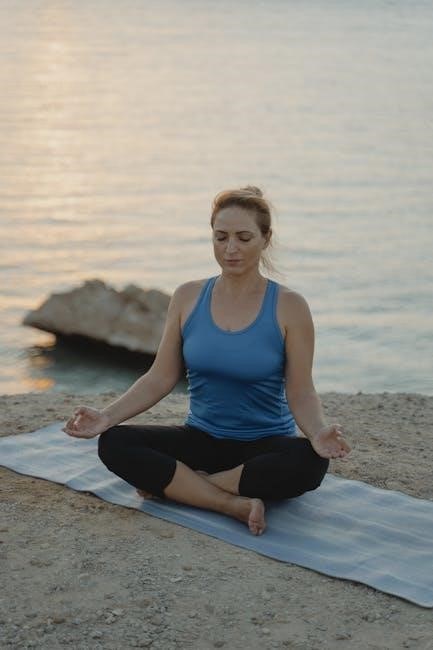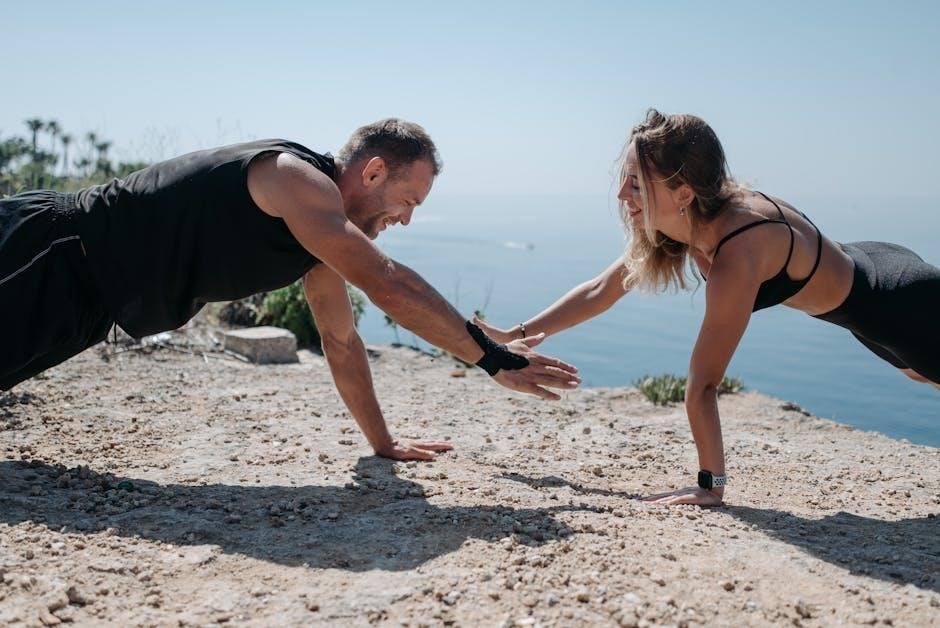The Schroth Method is a scoliosis-specific exercise approach, offering tailored exercises to address spinal curvature. It emphasizes 3D auto-correction, rotational breathing, and self-elongation for improved posture and pain reduction.
Overview of the Schroth Method
The Schroth Method is a scoliosis-specific exercise approach developed in Germany, focusing on 3D auto-correction, rotational angular breathing (RAB), and self-elongation. It is tailored to individual spinal curvatures, addressing both adolescents and adults. The method aims to halt curve progression, enhance posture, and improve aesthetics. Exercises are adapted for various scoliosis types, including kyphosis and complex spinal deformities. This approach emphasizes patient-specific modifications, making it versatile and effective for long-term spinal health management.
Importance of Scoliosis-Specific Exercises
Scoliosis-specific exercises, like the Schroth Method, are crucial for addressing spinal deformities effectively. They aim to stop curve progression, improve posture, and enhance aesthetics. These exercises are tailored to individual curve patterns, making them highly effective for both adolescents and adults. By focusing on 3D correction and breathing techniques, they improve spinal alignment and reduce pain. Regular practice can also boost confidence and overall quality of life, making them a vital component of conservative scoliosis management.

Core Principles of Schroth Exercises
Schroth Exercises focus on 3D auto-correction, self-elongation, and rotational breathing. These principles aim to derotate the spine, enhance posture, and manage scoliosis effectively through targeted movements and breathing techniques.
3D Auto-Correction and Self-Elongation
3D Auto-Correction is a cornerstone of Schroth Exercises, focusing on correcting spinal curvature in three dimensions. It involves specific movements to derotate the spine and enhance posture. Self-Elongation complements this by improving spinal flexibility and alignment, promoting a more upright position. Together, these principles help address scoliosis by targeting the spine’s rotation, curvature, and overall alignment, aiming to reduce the progression of spinal deformities and improve functional mobility.
These techniques are tailored to individual curve patterns, ensuring personalized treatment. Regular practice enhances spinal stability and reduces discomfort, fostering long-term postural improvements and better quality of life for patients with scoliosis.
Rotational Angular Breathing (RAB)
Rotational Angular Breathing (RAB) is a key component of Schroth Exercises, designed to address spinal rotation and improve posture. It involves specific breathing techniques that create forces to derotate the vertebrae and rib cage. During inhalation, collapsed areas of the spine and chest are expanded, while exhalation stabilizes the correction. RAB enhances spinal flexibility and promotes a more upright posture, making it a fundamental technique for scoliosis management and long-term postural improvement.
This breathing method is tailored to individual curve patterns, ensuring personalized effectiveness and comfort.
Curve Pattern Specific Exercises
Curve Pattern Specific Exercises are tailor-made to address individual spinal deformities, focusing on 3-curve and 4-curve configurations. These exercises target the unique aspects of each patient’s scoliosis, aiming to improve spinal alignment and reduce curvature progression. They are particularly effective for conditions like Scheuermann’s kyphosis and lumbar kyphosis, offering a personalized approach to enhance posture and mobility. By addressing the specific needs of each curve pattern, these exercises promote long-term spinal health and stability.

Benefits of Schroth Exercises
Schroth exercises offer significant benefits, including pain reduction, improved posture, and enhanced quality of life. Studies show 88% of patients experience curve improvement or stabilization.
Pain Reduction and Improved Aesthetics
Schroth exercises significantly reduce pain and improve spinal alignment, enhancing aesthetics. By addressing the root causes of discomfort, these exercises promote better posture and confidence. Studies show 88% of patients experience curve improvement or stabilization, leading to reduced discomfort. Techniques like rotational angular breathing and self-elongation help restore a more balanced spine, minimizing visible deformities. This approach not only alleviates physical strain but also boosts self-esteem, empowering individuals to manage their condition effectively and maintain an active lifestyle. Schroth’s holistic method ensures long-term benefits for both body and mind.
Enhanced Quality of Life
Schroth exercises significantly enhance quality of life by improving posture, reducing discomfort, and boosting confidence. Patients often experience better mobility and reduced fatigue, allowing for greater participation in daily activities. The method addresses both physical and emotional well-being, fostering independence and self-management. By empowering individuals to take control of their condition, Schroth exercises contribute to long-term emotional and physical well-being, enabling a more active and fulfilling lifestyle. This holistic approach ensures comprehensive benefits that extend beyond mere physical correction.
Compatibility with Bracing and Other Treatments
Schroth exercises are highly compatible with bracing and other conservative treatments for scoliosis. They enhance the effectiveness of braces by stabilizing the spine and improving posture during wear. The method complements physical therapy and other interventions, offering a comprehensive approach to managing spinal deformities. Additionally, Schroth exercises can be adapted to support patients undergoing bracing, ensuring optimal results. This integrative approach makes Schroth a versatile and effective component of multimodal scoliosis treatment plans.
Target Audience for Schroth Exercises
Schroth exercises benefit adolescents with idiopathic scoliosis, adults with scoliosis, and patients with related spinal conditions like Scheuermann’s kyphosis, offering tailored treatment for diverse spinal needs.
Adolescents with Idiopathic Scoliosis
Schroth exercises are highly effective for adolescents with idiopathic scoliosis, focusing on preventing curve progression and improving spinal alignment. Tailored to each patient’s curvature, these exercises combine rotational breathing, self-elongation, and 3D auto-correction. The goal is to enhance posture, reduce pain, and potentially avoid bracing or surgery. Regular practice helps adolescents gain control over their spinal deformity, fostering confidence and long-term spinal health. Exercises like the “door handle” exercise are commonly used to address specific curve patterns and promote active correction.
Adults with Scoliosis
Schroth exercises are beneficial for adults with scoliosis, focusing on pain reduction, improved posture, and enhanced quality of life. Tailored to address specific spinal curvatures, these exercises emphasize rotational breathing and self-elongation to stabilize and align the spine. Unlike adolescents, adults often prioritize symptom management over curve correction. Schroth exercises help adults maintain mobility, reduce discomfort, and improve aesthetics. They are particularly effective when combined with bracing or other conservative treatments, offering a holistic approach to managing scoliosis in adulthood.
Patients with Related Conditions (e.g., Scheuermann’s Kyphosis)
Schroth exercises are highly beneficial for patients with conditions like Scheuermann’s kyphosis, flatback syndrome, and hollow-back deformities. These exercises focus on restoring proper spinal alignment and reducing discomfort. Tailored to address specific curvature patterns, Schroth techniques such as Rotational Angular Breathing and self-elongation help improve posture and stabilize the spine. They are particularly effective for individuals with complex spinal deformities, offering a comprehensive approach to managing related conditions alongside scoliosis.

Exercises and Techniques
Schroth exercises include 3D auto-correction, self-elongation, and Rotational Angular Breathing (RAB). Techniques involve specific postures and breathing patterns tailored to individual spinal curvatures and conditions.
Foundational Schroth Exercises
Foundational Schroth exercises focus on 3D auto-correction, self-elongation, and Rotational Angular Breathing (RAB). Techniques like the 50 x Pezziball exercise and Prone Fig. 19a are commonly used. These exercises aim to correct posture, improve spinal alignment, and strengthen core muscles. They are tailored to individual spinal curvatures, addressing specific curve patterns. Regular practice helps stabilize the spine, reduce pain, and enhance overall mobility. These exercises form the basis of Schroth therapy, providing a structured approach to managing scoliosis effectively.
Advanced Techniques for Specific Curve Patterns
Advanced Schroth techniques target complex spinal curvatures, addressing individual curve patterns. Exercises like the door handle exercise and side-shift method are used for specific deformities. These techniques focus on derotation, deflection, and sagittal plane correction. They are tailored to 3-curve and 4-curve configurations, which are more common than often realized. Specialized breathing patterns and manual corrections enhance spinal alignment. These methods are particularly effective for patients with complex or rigid scoliosis, offering a personalized approach to improve posture and reduce discomfort.
Modifications for Different Scoliosis Types
Schroth exercises are tailored to address various scoliosis types, including thoracic, lumbar, and double major curves. Techniques like Rotational Angular Breathing (RAB) and auto-elongation are adapted for specific curve patterns. For instance, thoracic curves focus on derotation, while lumbar curves emphasize deflection. Bracing-compatible exercises integrate with brace wear to enhance correction. Additionally, modifications for Scheuermann’s kyphosis and flatback syndrome target sagittal plane alignment. These adjustments ensure personalized treatment, improving spinal alignment and reducing discomfort across diverse scoliosis types and related conditions.
Scientific Evidence and Research
Studies demonstrate Schroth exercises improve spinal alignment and reduce pain. Research, including randomized-controlled trials, shows an 88% success rate in halting curve progression in scoliosis patients.
Efficacy of Schroth Exercises in Scoliosis Treatment
Randomized-controlled studies highlight Schroth exercises’ effectiveness in improving spinal alignment and reducing pain. Research shows an 88% success rate in halting curve progression in scoliosis patients. These exercises are particularly beneficial for adolescents and adults, promoting long-term stability and enhanced quality of life. The method’s focus on 3D auto-correction and rotational breathing has proven to derotate the spine and expand collapsed areas, offering a non-invasive alternative to surgery. Schroth’s efficacy is well-documented, making it a cornerstone in scoliosis management worldwide.
Comparative Studies with Other Scoliosis Exercises
Comparative studies reveal that Schroth exercises often outperform other scoliosis-specific methods in halting curve progression. Research contrasts Schroth with approaches like BSPTS, SEAS, and FITS, highlighting Schroth’s unique 3D focus. Studies indicate Schroth’s rotational breathing and auto-correction techniques yield superior results in improving spinal alignment and reducing pain compared to traditional methods. Evidence shows Schroth exercises are more effective in preventing progression in adolescent idiopathic scoliosis, making them a preferred choice for long-term management and patient outcomes.
Long-Term Outcomes and Patient Success Stories
Studies demonstrate that Schroth exercises yield long-term improvements in spinal curvature and quality of life. Patients often report reduced pain and enhanced aesthetics. Success stories highlight individuals achieving significant curve stabilization and improved posture. For example, a 14-year-old patient with idiopathic scoliosis experienced reduced discomfort and greater confidence after consistent practice. Research shows 88% of participants improved or halted curve progression, underscoring Schroth’s effectiveness in long-term scoliosis management and patient empowerment.

Case Studies and Practical Applications
Clinical studies demonstrate Schroth exercises significantly improve spinal alignment and reduce pain. A case study of a 14-year-old with idiopathic scoliosis showed enhanced posture and confidence through consistent practice, highlighting the method’s real-world effectiveness.
Successful Treatment of Adolescent Idiopathic Scoliosis
Schroth exercises have proven effective in treating adolescent idiopathic scoliosis, with studies showing 88% of patients experiencing improvement or curve stabilization. Techniques like rotational breathing and self-elongation help correct spinal alignment. A case study of a 14-year-old girl demonstrated reduced pain and improved confidence after consistent practice. These exercises, tailored to individual curve patterns, empower adolescents to manage their condition actively, enhancing both physical and emotional well-being.
Exercises for Patients with Complex Spinal Deformities
Schroth exercises are tailored to address complex spinal deformities, including Scheuermann’s kyphosis and spondylolisthesis. Techniques like rotational breathing and self-elongation help correct multi-curve patterns. Customized programs focus on stabilizing and improving posture, reducing pain, and enhancing mobility. These exercises are particularly effective for patients with 3D spinal deformities, offering a proactive approach to managing complex conditions and improving overall spinal alignment.
Real-Life Examples of Schroth Exercise Programs
Real-life examples highlight the effectiveness of Schroth exercises in managing scoliosis. For instance, Ava, a teenager with scoliosis, experienced reduced pain and improved confidence through Schroth exercises. Specific exercises like the 50 x Pezziball and Prone exercises are commonly used. Studies show that 88% of patients who performed Schroth exercises experienced curve stabilization or improvement. These programs demonstrate how tailored exercises can address individual spinal needs, offering practical and measurable benefits for patients with scoliosis and related spinal conditions.

Resources and References
Christa Lehnert-Schroth’s book, “Three-Dimensional Treatment for Spinal Deformities,” and the Schroth Best Practice Academy guidelines provide comprehensive resources. PDF downloads and online courses offer detailed exercise manuals and evidence-based approaches.
Schroth Best Practice Academy Guidelines
The Schroth Best Practice Academy Guidelines provide evidence-based principles for scoliosis treatment. These guidelines emphasize 3D auto-correction, rotational angular breathing, and curve-specific exercises. They are developed by international experts to ensure standardized, effective care. The guidelines include detailed exercise protocols, bracing compatibility, and progression tracking. They serve as a valuable resource for both patients and professionals, ensuring optimal outcomes in scoliosis management. Regular updates reflect the latest research and clinical advancements in the field.
Christa Lehnert-Schroth’s Three-Dimensional Treatment Book
Christa Lehnert-Schroth’s book is a comprehensive guide to the Schroth method, detailing its three-dimensional approach for scoliosis treatment. It includes exercises tailored to individual spinal curvatures, emphasizing auto-correction and rotational breathing. The book provides practical applications for various curve patterns and serves as a valuable resource for both patients and professionals. It also highlights the method’s compatibility with bracing and its focus on improving posture, reducing pain, and enhancing quality of life through targeted exercises.
PDF Downloads and Online Courses
PDF downloads and online courses provide accessible resources for learning Schroth exercises. These materials include detailed exercise guides, treatment principles, and case studies. They cater to both patients and professionals, offering insights into scoliosis management. Online courses often feature video demonstrations and expert instruction, while PDFs serve as handy references. These resources are essential for understanding and implementing the Schroth method effectively, ensuring proper technique and progression in scoliosis treatment.
